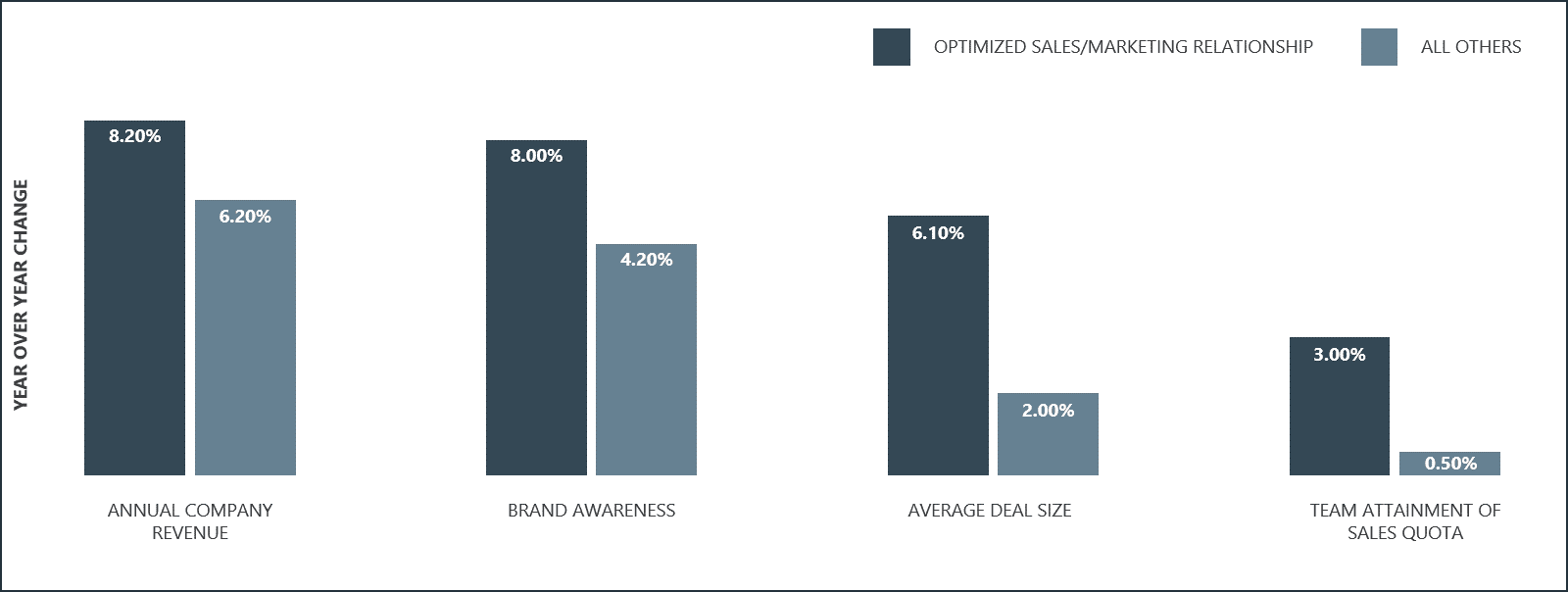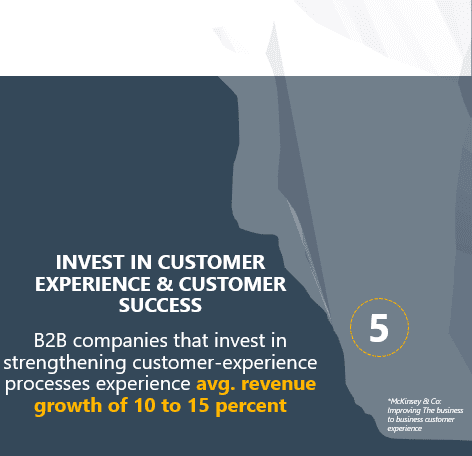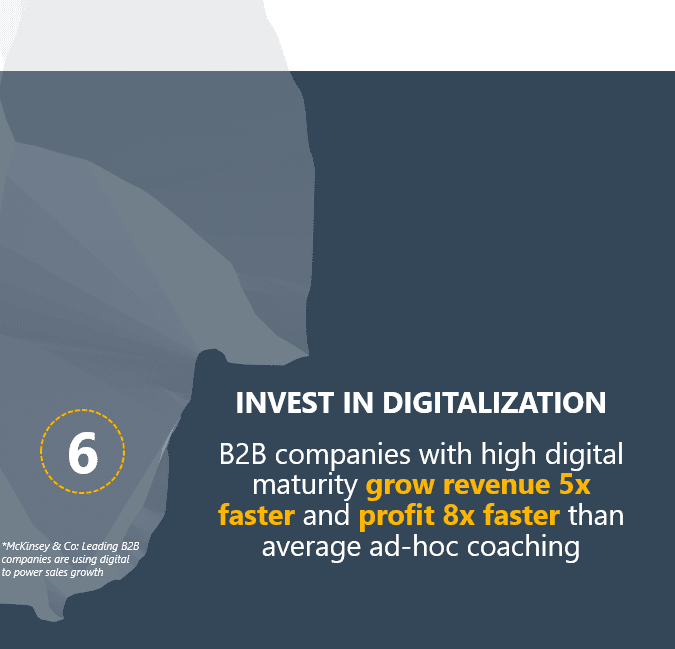Measuring sales success is simple (ability to hit sales & margin targets), but getting there is more tricky, as illustrated by the fact that the share of B2B sales rep meeting sales targets has been on a 5-year decline.
Successful sales-people & organisations are like other high performing individuals or teams; Results come from the things we don’t see.
Exhibit 1
The Six Hidden Elements of B2B Sales Success

For B2B sales, 6 “hidden elements” stand out as the strongest predictors of sales success:
1. Investment in training & people development
2. Defined sales process in place, to guide sales-people behaviour
3. Collaborates closely with marketing
4. Leverages sales management to drive front line sales rep behaviour and performance
5. Focus on customer experience & customer success
6. Takes advantage of new digital opportunities.
1. Invest in Training & People Development

Research shows that high-performing sales organizations are 2x more likely to provide ongoing training, compared to low-performing ones.
The strongest catalyst for sales success is to reinforce the training to make it stick. As most sales training focuses on a few days of training once a year and rarely provides structured playbooks and or follow-ups, the learning effectiveness decreases and makes it difficult for it to stick.
Research estimates that between 85-90% of training has no lasting effect after 120 days. Considering that the global market spend on B2B sales training is approximately €4.26 Bn it is clear that companies are wasting valuable resources on ineffective training activities.
Companies with success in reinforcing training to create sustained impact use these four activities:
- E-learning: Moving budget from the classroom training to reinforcement activities greatly improves sales training ROI because they are (a) less resource-demanding to conduct, and (b) maximized the results from the sales training. The key is to deliver the e-learning in bite-sized lessons while providing flexibility through multiple-device usage and on-the-go possibilities. By mixing the teaching activities, the methods of learning are varied as different levels of the learning pyramid becomes activated through listening, reading, watching audi-visuals & presentations, and practising.
Homework/certification tasks: Incorporating homework and a certification track will support the adaptation of the new methods and methodology. Research shows that on average it takes 66 days for a new skill to become a habit. By having small but frequent home assignments incorporated into a certification track, the participants are able to track their own progress towards a certification goal while adapting the new skills. - Sales manager coaching: Sales manager coaching is about maximising the potential of the team and its individual members. Making sure that coaching provided by sales managers around the training matches what is being taught, and keeps focus on implementation, is critical to making learning stick.
- Measure & Track Success (ROI): As companies on average spend €1,354 per sales rep on sales training, it is important to track whether it works or not. By setting up activity KPIs e.g. number of meetings held, number of customers contacted, number of follow-up emails sent, the sales reps are not measured on their quota but on their adoption and activity level.
2. Define Sales Processes to Guide Sales People

Companies that take the time and effort to define a sales process to guide their salespeople see an 18% increase in revenue growth.
Developing a formal sales process means having clearly defined stages and objectives that are commonly understood by the sales force. This means that the entire sales force should know where particular deals stand and how they should be managed at each stage of the pipeline.
The process should match the customers’ journey through their buying process to ensure they are met with the right approach. And since the sales process is a customer journey, it becomes a roadmap for the sales force.
Typically, the sales processes are defined developed as a part of pipeline management. Here, it is vital that the sales force have similar cadences and processes to follow through the various stages. This ensures that the salespeople spend their time on the correct deals, finding bottlenecks in terms of stalled deals, and improve forecasting and revenue. Opposite – if there are no structures or clearly defined cadences, the metrics in the pipeline will be futile to try to build insights upon.
A good sales process is never set in stone and should be regularly adapted to reflect the current state of the market, the customer’s needs, the sales force’s skills, and the business. It’s a blueprint for guidance, not a fixed process to be followed blindly.
3. Strengthen Collaboration Between Sales & Marketing

Sales organisations that collaborate closely with marketing see 38% higher average win rates and 36% higher customer retention, compared to average.
Commonly for companies succeeding is that their marketing and sales departments are aligned through mutual SLAs (Service level agreement). Even though misalignment and a lack of SLAs can cost more than 10% of the annual revenue, only 26% of B2B companies operate under one.
The most typical reason for misalignment is due to silo creation and lack of communication between the two departments. Though silos can be very difficult to break down, demolishing them and merging the two teams effectively can be highly beneficial for both departments and ultimately generate up to 208% more revenue.
Exhibit 2
The impact of optimizing the sales and marketing relationship

To successfully align your marketing and sales departments these 6 activities should be included:
- Weekly or bi-weekly meeting between the sales and marketing directors
- A Service Level Agreement between Sales & Marketing
- Collaborative future campaign planning sessions
- A uniform sales and marketing calendar
- Mutual metrics, milestones, and key success factors
- Monthly collaboration sessions between marketing & sales
Download Hubspot’s SLA Template here.
4. Leverage Sales Management to drive front-line growth

Sales organisations with a formalised coaching approach have 28% higher win-rates on forecasted deal, compared to organisations that use an ad-hoc coaching approach.
According to CSO Insights, sales coaching approaches can be divided into four maturity levels Random, Informal, Formal, and Dynamic. Not surprisingly, the formal and dynamic approach yields the highest impact on win rates for forecast deals while the random and informal approach performs below average. While most sales leaders agree that a formalized or dynamic approach to sales coaching is most effective, only 31% of companies operate with an approach that allows for top performance.
Formal sales coaching is characterised by having clearly defined coaching areas for different levels in the company. This means that sales managers are required to develop the sales coaching skills and apply them on regularly. In Addition, regular reviews are conducted to follow up on to continuously improve and learn from experience.
The dynamic sales coaching approach is an extension of the formal approach but includes the sales enablement framework for salespeople to ensure adoption and reinforcement of the investment in the salespeople. Furthermore, the sales managers are also measured and compensated accordingly.
To implement a dynamic approach, it is essential for the sales manager to have a clear and detailed picture on the sales force as it is necessary to monitor and track each salesperson to provide the correct coaching at the right time. The key to succeeding in driving front line growth through sales management is to manage the three sales processes:
- Sales Operations
- Sales Strategy
- Sales Analysis
Even though this approach has the highest impact, only 11% of companies operate at this level.
Sales organisations with a formalised coaching approach have 28% higher win-rates on forecasted deal, compared to organisations that use an ad-hoc coaching approach.
According to CSO Insights, sales coaching approaches can be divided into four maturity levels Random, Informal, Formal, and Dynamic. Not surprisingly, the formal and dynamic approach yields the highest impact on win rates for forecast deals while the random and informal approach performs below average. While most sales leaders agree that a formalized or dynamic approach to sales coaching is most effective, only 31% of companies operate with an approach that allows for top performance.
Formal sales coaching is characterised by having clearly defined coaching areas for different levels in the company. This means that sales managers are required to develop the sales coaching skills and apply them on regularly. In Addition, regular reviews are conducted to follow up on to continuously improve and learn from experience.
The dynamic sales coaching approach is an extension of the formal approach but includes the sales enablement framework for salespeople to ensure adoption and reinforcement of the investment in the salespeople. Furthermore, the sales managers are also measured and compensated accordingly.
To implement a dynamic approach, it is essential for the sales manager to have a clear and detailed picture on the sales force as it is necessary to monitor and track each salesperson to provide the correct coaching at the right time. The key to succeeding in driving front line growth through sales management is to manage the three sales processes:
- Sales Operations
- Sales Strategy
- Sales Analysis
Even though this approach has the highest impact, only 11% of companies operate at this level.
5. Invest in customer experience & customer success

B2B companies that invest in strengthening customer-experience processes experience avg. revenue growth of 10-15%.
In line with the 2.0 digitalisation era and the use of multiple different devices and different touchpoints with vendors it has become critical for B2C companies to offer top-class customer experience to cater to this demand.
Today, 8 out of 10 agree that professional buyers expect a consumer-grade digital experience from their websites. However, B2B companies are lacking behind as B2B companies score over 30% lower than B2C companies in customer-experience index ratings.
If experience isn’t your strategy, you’re doing it wrong…
Considering the B2C customer expectations and importance of frictionless customer journeys it is surprising that many companies tend to forget the importance hereof in B2B. Especially, when companies with great customer experience tend to have higher margins than their competitors, 10-20% reduction in cost to serve, and an increase in revenue growth of 10-15%.
This is due to the fact that on average 73% of people perceive customer experience to be an essential factor in their purchasing decisions and are even willing to pay more for greater convenience and a friendly, welcoming experience.
Today’s customer will choose other vendors if you cannot provide high-value, both physical and digital customer experiences. When searching for the right B2B vendor they gauge the experience against the best websites they have engaged with (Source). By implementing a high degree of buyer enablement – i.e. helping the buyer finding the right information or product depending on their current knowledge and where they are in their buying journey.
“Welcome to a new era of marketing and service in which your brand is defined by those who experience it.” – Brian Solis.
We need to understand the buyers and know what to provide them. We need to consistently provide high value and great user experience – both online and offline. As over 70% of buyers state that they are willing to move to a competitor after just 1 poor experience, it is crucial to put in the time and effort to cater to this.
Research from PwC shows that efficiency, convenience, friendly service and knowledgeable service is what people value the most in their customer experience. To cater for these wants, consider how your company website is structured. By having a website with great user experience and easy navigation, the buyer is supported on their own information-gathering journey at a smaller number of vendors. These vendors are often perceived as thought leaders within the expertise area and their chance of being chosen increases significantly.
6. Invest in Digitalization

B2B companies with high digital maturity grow revenue 5x faster and profit 8x faster than average ad-hoc coaching.
By embracing digitalization, a B2B company can begin using omnichannel to influence the buyer through multiple touch-points. Even though many people would relate this to B2C, it is important to stress that while what we buy in B2C and B2B differ, the way we buy – the why and how – are still influenced largely by the same human behaviour. Essentially, we tend to include human factors and not solely as a company. This means that we are often influenced by our colleagues, friends, and competitors when buying products and services in our work lives.
As buyers, we are also looking for stories to identify with and tend to be most convinced by our personal experiences. To reinforce this, research shows that multichannel customers are typically 15% more profitable than digital-only customers and over 25% more profitable than human-only experiences.
This is among other things caused by the fact that more than 63% of B2B buyers research their work purchases online with more than half of them doing it on their smartphone. By 2020, this number is expected to increases to 70%. Though the number of actual B2B purchases made on smartphones is still low, Forrester estimates that B2B e-commerce will grow steadily account for more than 12% of all B2B revenue by the end of 2020.
More importantly, is to consider how much the customer is influenced by own research – conducted on computer or smartphone. BCG claims that B2B mobile leaders are generating higher levels of search queries, website visitors, leads and transactions. Ultimately, the mobile leaders are experiencing a greater share – 42% on average – of revenue which is either mobile-driven or influenced.
In sum
In sum, this means that B2B companies need to stop perceiving digital activities only as a simple commercial order-entry channel. Instead, they need to perceive it as a necessity for omnichannel and the full-funnel end-to-end customer experience. Companies need to assess their website differently and look into new and better ways to provide value to their buyers.
In this article, 6 elements of B2B success was uncovered. Determining how and which to use – if any – greatly depends on the current state of the company. For many, it will be almost impossible to try to fully change an existing structure or routine overnight. However, the first step to succeed with such presented elements is to do it at an appropriate pace. Once some activities begin to show positive signs it will ease the managerial support and the budgets following the projects.
Another important note is to accept that there is a shift in the industry your company is in, rather than neglecting the reality. For example, to outperform competition, B2B companies must realize that their customers are rapidly changing – and that they need to change, too. Be careful not to be the “nay-sayer” and be left in the dust simply because “This isn’t relevant in your case”.
Embrace the change and take advantage of adapting to the new reality!



